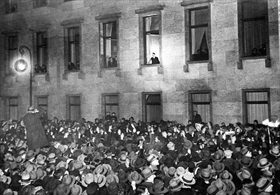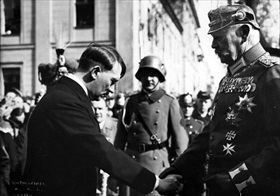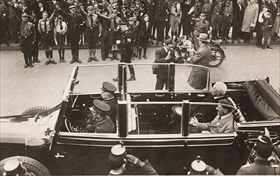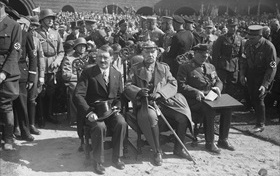NAZIS WIN BIG AT BALLOT BOX
Berlin, Germany · September 14, 1930
On this date in 1930 German voters went to the polls to elect a new Reichstag, and the results were shocking. The National Socialist German Workers’ Party (Nationalsozialistische Deutsche Arbeiterpartei, or NSDAP) was the ninth and smallest of Germany’s political parties, with but twelve members in the national parliament. In the elections of 1928 the NSDAP had captured a paltry 2.6 percent of the vote—810,000 votes out of 31 million cast. But the party’s outspoken, unconventional, dynamic leader, or Fuehrer, Adolf Hitler hoped to quadruple that number by capturing the imagination of a wide cross-section of voters, not just those who made up his extreme nationalist base. By the end of the day September 14, 1930, the election results exceeded Hitler’s wildest dreams: the Nazis, as party members were known, had won 107 seats in the Reichstag, which vaulted them into the second largest party in Germany. In the two general elections in 1932, Hitler’s party—helped by the militant tactics of his thuggish brown-shirted supporters, the SA (short for the German Sturmabteilung)—won 37 percent and 34 percent of the vote, which made the Nazi Party the largest party in the Reichstag. Hitler didn’t have a majority of seats, but he had enough that politicians and the electorate had to take him seriously. In the tempest of parliamentary politics in late January 1933 President Paul von Hindenburg named Hitler Chancellor of Germany and head of yet another coalition government in the Weimar Republic, an entity spawned in the aftermath of the widely despised 1919 Versailles settlement. Within months of being named chancellor Hitler headed a totalitarian government. With the death of 87-year-old President Hindenburg on August 2, 1934, Hitler lickety-split ordered a plebiscite for August 19, seeking approval to combine the offices of president and chancellor. Germany’s voters went to the polls and a whopping 90 percent voted Ja. The next day the cabinet decreed the “Law on the Allegiance of Civil Servants and Soldiers of the Armed Forces.” Known as the Hitler Oath, the law required armed forces and civil service personnel to swear obedience to the “Bavarian corporal,” as Hindenburg once referred to Hitler, instead of obedience to the German constitution or nation. From that day on Hitler ruled his nation by decree.
![]()
[amazon_carousel widget_type=”ASINList” width=”600″ height=”200″ title=”Recommended Reading” market_place=”US” shuffle_products=”False” show_border=”False” asin=”0813190983,1845456807,1563115956,1616086084,140826921X,0786477296,0312233515,0674350928,0307389588,0143034693″ /]
The Rise of der Fuehrer Adolf Hitler, 1930–1934
 |  |
Left: Newly appointed Chancellor Hitler at the window of the Reich Chancellery on Berlin’s Wilhelmstrasse receiving ovations on the evening of January 30, 1933. President Hindenburg (elected second president of the Weimar Republic in 1925) was no admirer of Hitler and initially refused to name him chancellor. Instead, he appointed fellow army officer Maj. Gen. Kurt von Schleicher to the position. Political intrigue, cabinet crises, and backroom negotiations prompted an exasperated Hindenburg to end government instability by appointing Hitler to head a new cabinet and naming ex-Chancellor Franz von Papen as vice-chancellor, with the understanding that Papen would act as a “check” on Hitler’s more disturbing tendencies and encourage him to tamp down on the lawlessness and ruthlessness of the SA, his party’s paramilitary thugs.
![]()
Right: Hindenburg and Hitler on March 21, 1933, known as the “Day of Potsdam.” On that day the newly elected Reichstag was constituted with an opening ceremony in Potsdam’s Baroque Garrison Church. (A new venue was made necessary by the Reichstag fire on February 27, 1933.) The Potsdam gala was a Nazi propaganda pitch to demonstrate unity between the Hitler’s populist movement and the old aristocratic, conservative, and Prussian military elite represented by Hindenburg.
 |  |
Left: Hindenburg and Hitler ride in an open-top car at the May Day rally, where Hindenburg had delivered a speech in Berlin’s Lustgarten, May 1, 1933. The day had been declared the “Day of National Labor.” Twenty-four hours later Hitler banned and disbanded German trade unions.
![]()
Right: Hitler, Hindenburg, and Hermann Goering at a massive demonstration at the Tannenberg Memorial near Tannenberg, East Prussia (today Olsztyn, Poland) in August 1933. The castle-like memorial of eight towers around a central courtyard commemorated the anniversary of the Second Battle of Tannenberg (August 23–30, 1914), a victory over the Russians that made Field Marshal Hindenburg a national hero. Against his wishes Hindenburg was buried in the central yard of the Tannenberg Memorial during a large state funeral—this on August 7, 1934, five days after his death.
Hindenburg’s Funeral at Tannenberg Memorial, August 7, 1934; Hitler Addresses Mourners
![]()

 History buffs, there is good news! The Daily Chronicles of World War II is now available as an ebook for $4.99 on Amazon.com. Containing a year’s worth of dated entries from this website, the ebook brings the story of this tumultuous era to life in a compelling, authoritative, and succinct manner. Featuring inventive navigation aids, the ebook enables readers to instantly move forward or backward by month and date to different dated entries. Simple and elegant! Click
History buffs, there is good news! The Daily Chronicles of World War II is now available as an ebook for $4.99 on Amazon.com. Containing a year’s worth of dated entries from this website, the ebook brings the story of this tumultuous era to life in a compelling, authoritative, and succinct manner. Featuring inventive navigation aids, the ebook enables readers to instantly move forward or backward by month and date to different dated entries. Simple and elegant! Click 











